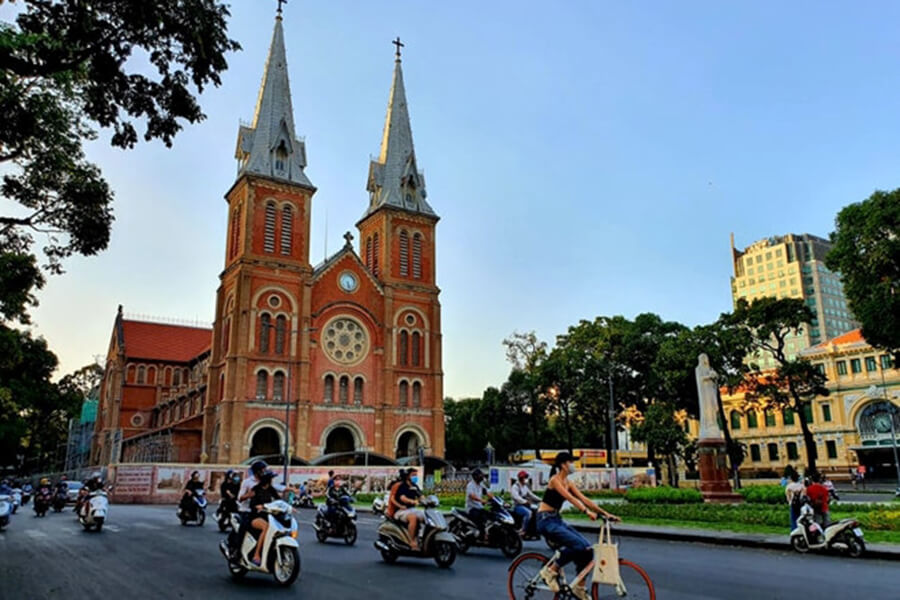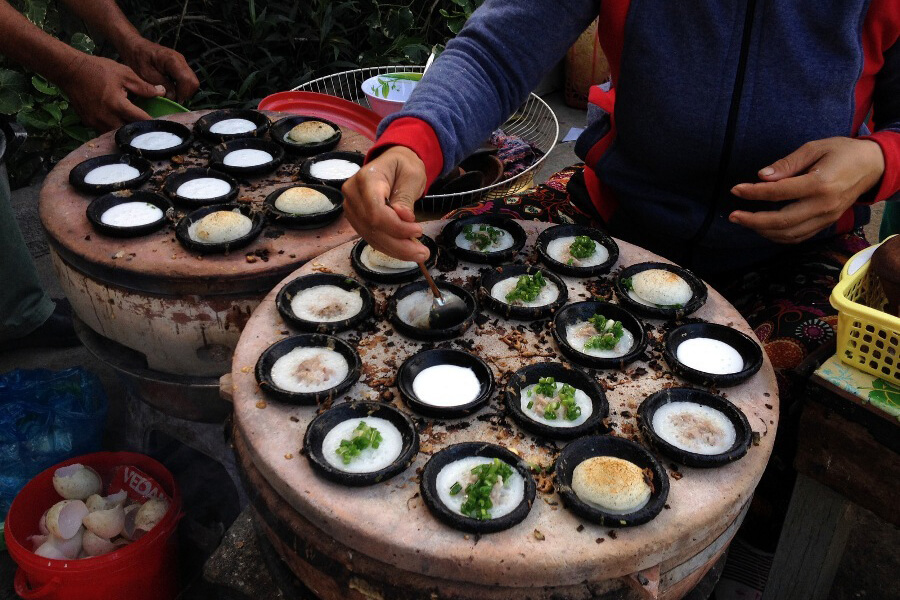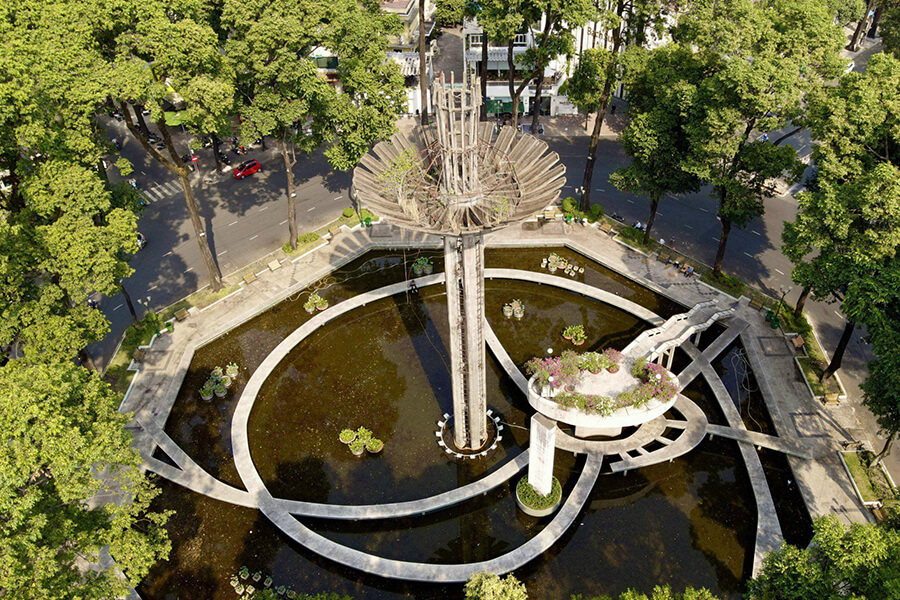Saigon Notre Dame Cathedral is a check-in spot not to be missed when coming to Ho Chi Minh City. With ancient French architecture and luxurious space from the outside to the inside of the cathedral, this location is considered the largest Catholic church in Vietnam and also one of the symbols of Saigon.
Where is Saigon Notre-Dame Conathedral?
Address: Paris Square, Ben Nghe Ward, District 1, Ho Chi Minh City
Notre-Dame Cathedral, commonly referred to as Saigon Notre-Dame Cathedral, is a popular shorthand among locals for convenient use. The full name of this structure is the Immaculate Conception Cathedral Basilica, also known as the Notre-Dame Cathedral Basilica of Our Lady.
The cathedral has a length of 91m, a width of 35.5m, and the main roof vault reaches a height of 21m. The two bell towers on either side stand at nearly 57m in height. Notre-Dame Cathedral Basilica in Saigon showcases a classic French architectural style, designed by the talented architect J. Bourard. The exterior of the cathedral is spacious and airy, while the interior exudes elegance and reverence. According to Saigonlocaltour, it is one of the most iconic attractions in Saigon, beloved by both domestic and international tourists.
History of Saigon Notre-Dame Cathedral
History of Saigon Notre-Dame Cathedral begins with the French invasion towards the end of the 19th century. The French government at the time aimed to construct a large cathedral to serve the community and cater to religious activities for the French authorities and military personnel. The first church was initially located on Ngô Đức Kế Street but was deemed too small, leading French Admiral Bonard to decide on building a larger cathedral.
Construction of Saigon Notre-Dame Cathedral Basilica commenced on March 28, 1863. Within two years, the cathedral was completed. By 1895, the French added two bell towers, each surrounded by six small bronze bells. At the top of each tower, a cross measuring 3.5m in height, 2m in width, and weighing 600kg was designed. At this point, the height of the building, from the ground to its highest point, was 60.5m.
The French also commissioned a bronze statue of Pigneau de Behaine (also known as Bishop Adran) leading Prince Canh, the eldest son of King Gia Long. This statue was placed in front of the cathedral. In 1945, the statue was destroyed, but the statue's base remains intact.
In 1959, Bishop Joseph Phạm Văn Thiện commissioned a statue of Our Lady of Peace from Rome. On February 7, 1959, Cardinal Agagianian from Rome presided over the solemn statue dedication ceremony. Since then, the cathedral has been commonly referred to by locals as Saigon Notre-Dame Cathedral Basilica.
In 1960, Pope John XXIII established the Roman Catholic Diocese in Vietnam, and the cathedral's name was changed to Saigon Notre-Dame Cathedral Basilica. In 1962, the Pope bestowed the title "Basilica" upon the cathedral.
Renovation Process of Saigon Notre-Dame Cathedral
Up to the present day, this cathedral has undergone three major renovations. The first renovation involved the construction of pointed bell towers in 1895. The second, in 1903, focused on elevating the front facade, creating a flower garden, and installing the statue of Peaceful Bodhisattva. The third was the installation of the statue of Our Lady of Peace in 1959.
Currently, Saigon Notre-Dame Cathedral is undergoing its fourth renovation, a comprehensive project that commenced in August 2017. Originally scheduled for completion in June 2020, due to various issues, the repair work is now expected to conclude in 2027.
Throughout the renovation process, the cathedral remains open to welcome Catholic worshippers every Sunday. Especially at 9:30 AM every Sunday, there is a bilingual (Vietnamese and English) Mass. For tourists and visitors, the grounds and the square in front of Saigon Notre-Dame Cathedral Basilica are still accessible for strolling and photography.
Highlights in the Architecture of Saigon Notre-Dame Cathedral
Materials and Architecture
Saigon Notre-Dame Cathedral was constructed in the Neo-Romanesque architectural style, also known as Romanesque Revival. This architectural style gained popularity in the mid-19th century, drawing inspiration from the Romanesque architecture of the 11th and 12th centuries. Buildings in this style are characterized by vaulted ceilings and simple window designs.
During the construction of Saigon Notre-Dame Cathedral, all materials, from cement and steel to screws, were imported from France. The exterior of the structure was made from bricks manufactured in Marseille. The advantage of these bricks is that they do not require plastering, do not accumulate moss or dust, and maintain their bright pink color over the decades. The entire cathedral boasts 56 stained glass windows, crafted in the province of Chartres, France.
Design of Saigon Notre-Dame Cathedral
The foundation of the cathedral was specially designed to bear a load ten times the total weight of the entire architectural structure. One distinctive feature is that the church lacks fences or walls, unlike other churches in the Saigon-Gia Dinh region at the time.
The interior of the cathedral features two main rectangular aisles, each with six rows symbolizing the twelve apostles. The altar of Saigon Notre-Dame Cathedral is crafted from solid granite with six angels carved into the stone. The altar is divided into three sections, each depicting a sculpted scene of a miracle.
The walls are adorned with 56 stained glass windows depicting characters or events from the Bible, 31 circular rose windows, and 25 multi-colored bull's-eye windows combined with beautiful images. Every line, molding, and pattern follows the dignified and elegant style of Roman and Gothic architecture. However, out of these 56 stained glass windows, only 4 remain intact. The rest were repaired in 1949 due to damage from the war.
Bell Tower of Saigon Notre-Dame Cathedral
In its original design, the two bell towers were 36.6m tall, had no roofs, and featured a narrow staircase of about 40cm width. The interior was dimly lit, and the floor was paved with small wooden pieces. In 1895, the church added two roofs to cover the bell towers, each 21m high, designed by architect Gardes, making the total height of the bell towers 57m. All six bells are suspended between the two bell towers. These bells were made in France and brought to Saigon in 1879.
The bells are controlled electrically from below. On regular days, Saigon Notre-Dame Cathedral only rings the bells at 5 AM and 4:15 PM. On holidays and Sundays, the church typically rings the bells three times. When all six bells chime simultaneously, the sound is quite loud, audible from a distance of up to 10km.
Between the two bell towers, a very large clock is placed. Manufactured in 1887, it weighs a whopping 1 ton. Despite being over a century old, the clock still operates very accurately.
Small Square in Front of Notre-Dame Cathedral
Paris Commune Square, situated between Notre-Dame Cathedral and Nguyen Du Street, features prominently the statue of Our Lady of Peace at its center. This area is a popular stop for visitors, offering a space to enjoy coffee, take photos, and admire pigeons. Particularly on weekend mornings, it attracts a lively crowd of young people who gather here for conversations and leisure activities.
The image of Notre-Dame Cathedral has long become a symbol representing the splendid land of Saigon. Nearby attractions include Independence Palace and the City Post Office. Combining a visit to these three famous landmarks allows you to explore Saigon in its entirety.
Park Area Surrounding Notre-Dame Cathedral
Paris Commune Square, situated between Notre-Dame Cathedral and Nguyen Du Street, features prominently the statue of Our Lady of Peace at its center. This area is a popular stop for visitors, offering a space to enjoy coffee, take photos, and admire pigeons. Particularly on weekend mornings, it attracts a lively crowd of young people who gather here for conversations and leisure activities.
The image of Notre-Dame Cathedral has long become a symbol representing the splendid land of Saigon. Nearby attractions include Independence Palace and the City Post Office. Combining a visit to these three famous landmarks allows you to explore Saigon in its entirety.
Experience Visiting Saigon Notre-Dame Cathedral
Getting to Notre-Dame Cathedral
This location is situated in the heart of District 1, Ho Chi Minh City, making it easily accessible. If you are staying in one of the nearby hotels, you can conveniently walk to the cathedral and take advantage of the opportunity to admire the beautiful scenery of Saigon. If you are a bit farther away, taxis are always a convenient and reasonably priced option for travel in any location. They provide quick transportation.
However, if you prefer a more proactive approach to your sightseeing journey, you can also rent a self-driving motorbike. Each motorbike has a reasonably priced rental fee of 100,000 VND per day. Make sure to note the directions to avoid getting lost amidst the intersections in Saigon! Upon arrival, you can park your bike at venues such as the Reunification Palace, Hoa Binh Square, or the Youth Cultural House. Additionally, other public transportation options such as motorbike taxis, cyclos, or buses are also popular choices among many tourists.
Accommodation Options Near Notre-Dame Cathedral
If you don't know which Saigon hotel to choose near this church, you can check out the list suggested by Saigonlocaltour below.
Park Hyatt Saigon Hotel: This hotel was voted by the prestigious Travel + Leisure magazine as one of the 500 best hotels in the world for 4 consecutive years. This hotel near Notre Dame Cathedral attracts tourists with its harmonious combination of modernity, luxury and nobility.
Muong Thanh Grand Saigon Center Hotel meets 4-star standards with 124 diverse rooms, suitable for the preferences and relaxation needs of each traveler. The room system is fully equipped with modern equipment to provide guests with a top resort experience.
Novotel Saigon Center Hotel with its luxurious resort space and reasonable price is the top choice of many tourists when coming to Saigon. From this hotel, you can easily travel to Notre Dame Cathedral by many different types of transportation.
InterContinental Saigon Hotel has been in operation since 2009, under the management of the world's leading hotel group InterContinental Hotels Group. European-style hotel with modern facilities and classy space will be the top choice for your visit to Notre Dame Cathedral.
Central Palace Hotel owns a system of luxurious rooms and diverse resort services. When staying here, you can enjoy premium health and beauty services.
Vinpearl Landmark 81 Hotel's prime location will help you easily move to this church and other famous attractions in Ho Chi Minh City. In addition, luxury hotel rooms and services will also give you the best vacation experience.
Best Time to Visit Notre-Dame Cathedral
The church is open free of charge for visitors to visit, however you should stay during church service hours to fully explore the unique experiences here. Specifically, the church's mass hours are at 5:30 and 1730, from Monday to Saturday every week. On Sunday, the time slots will be more diverse, including 5:30, 6:45, 8:00, 9:30 and some afternoon time slots at 4:00 pm, 5:15 pm, 6:30 pm.
Where to Eat Near Notre-Dame Cathedral?
When you're here, what should you eat near Notre-Dame Cathedral? Visitors can indulge in delicious street food, such as:
Saigon Coffee: Enjoy a cup of Saigon iced milk coffee at the nearby coffee shops. The city's signature iced coffee is often referred to as "Uncle's Coffee."
Street Food Delights: Explore the unique street food scene in Saigon with tempting dishes like:
- Crab Soup (Súp Cua): An enticing dish with the delicious flavor of crab.
- Mini Pancakes (Bánh Căn): Small, crispy rice pancakes often served with a sweet and sour fish sauce
- Hu Tieu Noodles: A Southern-style noodle soup with flavorful broth and distinctive spices.
- Mixed Rice Paper (Bánh Tráng Trộn): A popular snack with shredded rice paper mixed with various ingredients like shrimp, beef, fresh herbs, and spices.
- Fried Rice Flour Cake (Bột Chiên): Famous for its crispy texture and unique flavor.
Nearby Attractions to Visit Alongside Saigon Notre-Dame Cathedral
After visiting Notre Dame Cathedral, you can visit other famous landmarks in the area such as:
- Independence Palace
- Turtle Lake
- Vietnam History Museum
- Bitexco Financial Tower
- “Check-in in the clouds” at Landmark 81
- Nguyen Hue Walking Street
- Ben Thanh Market











